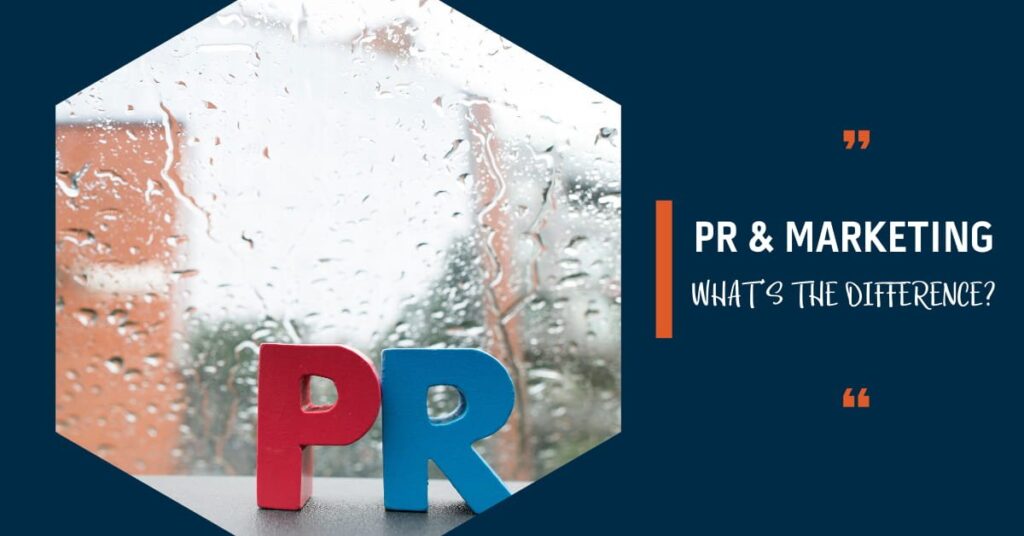PR and Marketing… Pretty much the same thing, right? Well, no. Social media may have blurred the lines between marketing and public relations, but distinctions still exist between the two. A successful business needs both.
The difference between PR and Marketing?
Marketing and PR both fall under the same large umbrella, covering all aspects of alerting people to your business activity, but they execute this in different ways and aim for different outcomes.
That’s not to say they don’t work brilliantly together, but the two must be coordinated carefully. When it comes to creating PR strategies and marketing strategies think about the following differences:
Sales vs Brand Awareness
Marketing exists to drive sales of a product or service, often targeting individuals, prospective customers, or small demographic groups in a very specific way.
Whether it’s offline or digital marketing, the result is one of the factors that heavily influences the bottom line of a business. Progress made over the life of a campaign is easily measurable.
PR is less easy to measure. Its aim is to support and maintain a positive image of the business and brand as a whole, rather than promote particular products or services.
Public relations create awareness of the business outside its core customer base and target audience - including employees, suppliers and the media.
Advertising vs Relationships
Marketing teams primarily use a range of advertising techniques to reach customers. These will be managed strategically according to the nature of the business and its intended market.
PR agencies, on the other hand, aim to build relationships between the business and the wider public via reputation management and creating credibility in the brand.
Human connection across all lines of communication is vitally important, as are the advantages of a good rapport with the press and media, as well as with customers.
Proactive vs Reactive
Marketing has been described as proactive, as the intention is to drive sales and boost profits, whereas PR is sometimes viewed as reactive.
It is true that great PR can turn a disaster into a triumph, but actually, PR needs to be every bit as proactive as marketing - well planned, consistent and regularly reviewed.
The Role Of Social Media
Social media has certainly contributed to the difficulty of distinguishing between PR and marketing.
Businesses can now sell products, make announcements, find influencers, maintain a positive reputation, and manage customer relationships almost simultaneously across many channels.
A strong advertising campaign that demonstrates a caring and aware business, as well as a high-quality product, can create sales and great PR at the same time. Innocent Drinks are a fantastic example of marketing and PR working brilliantly together.
PR for your Business
Knapton Wright have been working with businesses and brands to make their marketing as successful as possible for more than 5 years.
We have experts in all areas, and we are completely up-to-date with industry developments and innovations.
However, PR is a newer art to us. The expertise is here, but we haven’t talked about it much yet.
So, if you’d like to understand how it works, and bring a little PR magic to your business or brand, we’ve put together a few key tips that will help your message reach your audience and media outlets credibly and memorably.
- Whatever marketing medium you’re using to reach your audience, be it social media or something more traditional, make sure you’re always thinking about the human angle. Nobody likes communicating with a machine more than a person. If communication cannot be carried out on a one-to-one level, then it has to be as personal as possible in order to build trust and respect. The message has to be conveyed in a way that is perceived as being caring and showing emotion to some extent.
- When trying to draw a story to the attention of the general public you’ll only really be successful if there’s some actual news value in it. So give this some consideration before you even begin. The idea is to generate interest in a business or brand, rather than sell a product. If the story has an impact on people (factory staff raising money for charity, rather than the same factory building an extra car park), it will generate more interest. If your chosen audience is smaller or more niche, and you’re looking for coverage in a trade magazine or forum, make sure the information you’re providing is valuable. Share your own personal expertise or the experience and skills your business draws on to benefit others.
- You may have to build a story around whatever message you’re trying to get across. Try to think outside the box a little - what can you do differently to bring the story to the attention of the right people? When you’re promoting a piece of news or an event, make sure you cover the 6 basic areas: WHO, WHAT, WHY, WHERE, WHEN AND HOW.
- Keep engaging with your audience and be consistent. You’ll build up trust if you’re seen to offer good advice regularly with no expectation of anything in return. The more you engage, the more you’ll deepen relationships. You’ll become known as an expert, your business or brand will gain credibility, and your audience will grow and grow.
Marketing and PR - yes, definitely different, but each becomes stronger when used with the other. It’s time to put the two together.
Rachel Davey
Studio Manager




